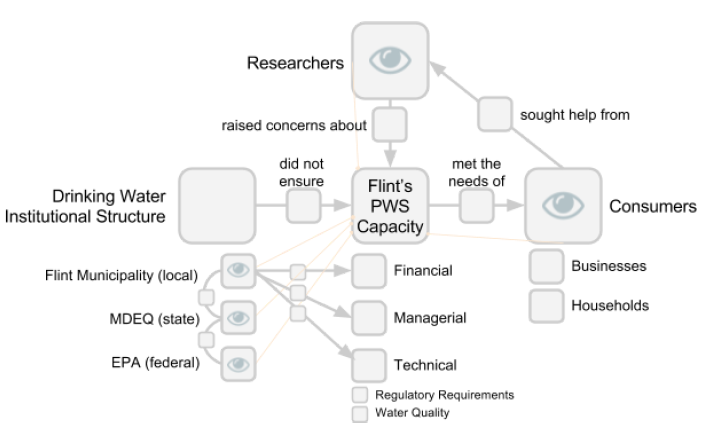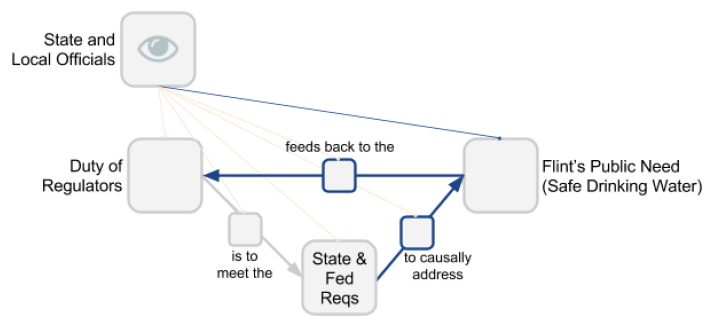Edited by Ranissa Adityavarman
The drinking water crisis in Flint, Michigan, began in April 2014, after city officials—in an effort to balance the water system’s checkbook— decided to switch the city’s water source, moving from purchasing treated water from Detroit to supplying water from the Flint River. This event and those officials’ subsequent decisions exposed Flint residents to high levels of lead leaching from the pipes for more than a year. Children are particularly vulnerable to lead exposure, as high levels of lead in children’s blood can put them at risk for developmental problems.[1] During the crisis, between 6,000 and 12,000 children were exposed to drinking lead-contaminated water.[2] Recognizing the severity of the crisis, President Barack Obama declared Flint in a federal state of emergency in January 2016.[3]
A Nationwide Problem
This is not the first time a city has faced lead contamination in their drinking water. Thirteen years before the crisis in Flint, lead contamination occurred in the Washington, D.C. water system. Dr. Marc Edwards of Virginia Tech—the man who brought light to the crisis in Flint through rigorous water quality analyses—found that the elevated levels of lead in the D.C. water were due to the chemical chloramine, which had caused lead service lines to corrode.[4],[5] Flint and D.C. are not unique among U.S. water systems, either. In fact, primarily due to aging drinking water infrastructure, more than 5,300 water systems are in violation of the Lead and Copper Rule, these violations include water systems that failed to properly test for lead, as demonstrated in Figure 1.[6]

Figure 1: Community water systems with violations of the federal Lead and Copper Rule in 2015. [7] (Photo: Natural Resource Defense Council)
In Systems Thinking Made Simple, Derek and Laura Cabrera describe the importance of “cognitive structure in the formulation of new knowledge.”[8] Dr. Derek Cabrera identified four cognitive rules, making distinctions, systems, perspectives and relationships, which act as the building blocks for all thought. When these rules are applied to complex topics they can help to structure information through thinking. These cognitive structures can be applied to complex problems, like the Flint water crisis, to identify critical failures in existing mental models and to remedy these shortfalls.
Using Structure to Understand Complex Problems
DSRP can help to structure one’s thinking about a complex, multifaceted problem like the crisis in Flint.
The ‘systems’ rule facilitates the construction of structural meaning by breaking ideas into part-whole configurations. The Cabreras describe a “system” as “Any idea or thing can be split into parts or lumped into a whole.”[9] Systems are thus made up of two components, wholes and parts. As we think through problems in our world, such as the case of Flint, we must understand the relevant wholes and the parts separated from those wholes.
Second, to better understand the relationships between the parts and the whole, we must employ the ‘relationship’ rule, according to which “Any thing or idea can relate to other things or ideas.”[10] Like systems, relationships are composed of two parts: action and reaction. By explicitly recognizing and defining the nature of these relationships, we deepen our understanding of the system’s operation, as well as the consequences and effects that arise from the interplay of actions and reactions.
Third, complex problems like the Flint water crisis can be viewed and analyzed from various perspectives, which often create the need for systems thinking in the first place.[11] The ‘perspectives’ rule observes that “Any thing or idea can be the point or view of a perspective,” where the ‘view’ is what is seen and the ‘point’ is the seer.[12] For example, the water crisis (the view) can be analyzed from the perspective of Flint’s residents (the point). Likewise, these roles can be reversed, where Flint’s residents (the view) can be analyzed from the perspective of the water crisis (the point). These perspectives are often built into mental models that we use such that we are often unaware we are taking a perspective at all.
Finally, the ‘distinction’ rule states that “Any idea or thing can be distinguished from the other ideas or things it is with.” Distinction-making entails the creation of both an ‘identity’, which is a specific idea or thing, and an ‘other’, which can be anything but that idea or thing. As with perspective-taking, distinction-making is also often an unconscious act that can lead to biases and consequently to larger problems—including major public health crises, as in the case of Flint. Making distinctions, identifying systems and relationships, and understanding perspectives can help to conceptualize complex problems, like the Flint water crisis, paving the way toward identifying and rectifying critical failures.
What Happened in Flint?
The Structure of Flint’s Water System: Recognizing Part-Whole Systems and Relationships
The Flint water system is monitored and regulated by an institutional structure of environmental and public health regulatory agencies. These agencies are responsible for maintaining Flint’s water system capacity, or ability to produce safe drinking water. In Flint, this institutional structure includes: (1) local officials at the Flint municipality, who are in charge of managing the capacity of the water system to provide safe drinking water to the public; (2) state officials at the Michigan Department of Environmental Quality (MDEQ), who provide continued support to the municipality and ensure the compliance of the public water system (PWS); and (3) federal officials at the Environmental Protection Agency (EPA) who support the efforts of the state through the provision of regulations and guidance.[13] This system of actors works to maintain the capacity of Flint’s water system and deliver safe drinking water to the City of Flint, which includes businesses, such as GM Motors, and households.
Flint’s water system capacity is itself a complex system comprised of distinct, interrelated capabilities that, if met, can help to ensure the effectiveness of the water municipality. This system includes the technical, managerial and financial (TMF) capabilities of the municipality. As Figure 2 demonstrates, short- and long-term planning (conducted at the local level, and supported by the state and federal regulators) aim to maintain the TMF capacity of the water system.

Figure 2: The functioning of a water system depends on its technical, managerial and financial capacity.[14]
How the Structure Failed
A deficiency in the Flint water system’s financial capacity led to the water supply switch that sparked the crisis. In 2011, Flint had a $15 million budget deficit. City officials’ decision to stop purchasing water from Detroit and to instead treat water from their own source, the Flint River, saved Flint $9.2 million.[15] This reaction to Flint’s financial troubles could have been an effective solution to the financial crisis, as the Flint River—once treated—is considered a suitable source of drinking water.[16] While the financial capabilities of the Flint municipality were adequate, the city officials failed to ensure the technical and managerial capabilities of the water system.
Flint’s state and local officials committed a significant technical failure when they did not install a corrosion control system. This rule states that community PWSs with over 50,000 people must implement corrosion control treatment, where Flint has a population of more than 95,000 people. MDEQ officials were tasked with supporting Flint in the planning process. However, MDEQ staff had never worked on this type of water system switching sources, and later recognized they were unfamiliar with the requirement in the Lead and Copper Rule that a corrosion control system must be installed.[17] Therefore, MDEQ failed to provide the Flint municipality with the necessary support.[18] Thus, the corrosive water from the Flint River caused lead to leach from Flint’s aging pipes into the water supply. MDEQ did not notify EPA until April 2015 (the year following the switch) that Flint did not have a corrosion control plan. While EPA officials had the expertise and experience to address the problem, the state did not effectively use them as a resource, further escalating the problem. EPA was also at fault, as a report from the Office of Inspector General[19] found that had sufficient information and authority to issue an emergency order under the Safe Drinking Water Act as early as June 2015 (EPA did not issue the order until seven months later, January 21, 2016).[20] Due to these failed relationships, local officials did not have the necessary support to manage the water system’s technical, managerial and financial capacity, particularly pertaining to the system’s technical capacity.
While water quality samples taken by the Flint water system in accordance with the Lead and Copper Rule appeared to meet state and federal lead standards, children became sick as lead leached into the water. In the end, several factors (to be discussed in detail later) would reveal that Flint’s water system did not meet the regulatory requirements for lead. A water quality test performed by the City at the request of resident Lee Ann Walters on February 25, 2015 showed lead levels of 104 parts per billion (ppb), well beyond the federal limit of 15 ppb.[21]
In response to these water quality results and Flint’s failure to install corrosion control treatment, EPA wrote an internal memo on June 24, 2015, copying staff from MDEQ, advising that action be taken. The memo was then leaked to the press in early July, raising the public’s attention to the issue. However, MDEQ’s perspective was influenced by the regulatory results that demonstrated Flint’s compliance with the requirements of the Lead and Copper Rule. In response to an American Civil Liberties Union (ACLU) inquiry about the leaked EPA memo to MDEQ, MDEQ spokesman Brad Wurfel stated that “…anyone who is concerned about lead in the drinking water in Flint can relax.” He explained the Walters’ home was an “outlier” and that “it does not look like there is any broad problem with the water supply freeing up lead as it goes into homes.”[22]
Wurfel’s statement illustrates that throughout the crisis, local and state officials failed to effectively communicate with stakeholders. Not only did officials fail to report potential health concerns, but they also did not act on the apprehensions voiced by citizens and businesses about the about the change in water quality after Flint changed their water source (Figure 3).

Figure 3: Customers found a stark contrast in their water’s appearance after Flint switched its water source. (Photo: Tabitha M. Powledge, The Public Library of Science[23])
After Flint changed water sources, residents noticed that the water coming out of the faucet was no longer clear: it had a tint that ranged between brown and blue, and it smelled of rotting eggs.[24] Further, many parents noticed that their children were experiencing rashes, and some became extremely sick.[25] Customers’ perspective of their water system’s capacity had changed and they lost trust in the safety of their water. They lodged complaints with the City and began to use only bottled water (see Figure 4). This real-world feedback from stakeholders, if considered by officials, had the potential to stop the crisis in its tracks. Instead, the problems persisted for more than a year after early concerns were expressed, as officials ensured the public that the water was meeting all state and federal water quality standards.[26]

Figure 4: Flint resident rinsing her fish with bottled water. Even after their lead pipelines are replaced, residents do not trust their water. (Photo: Brittany Greeson for the New York Times[27])
As Flint’s customers could no longer rely on the existing structural system, in which the local, state and federal actors would be responsible for managing the system for safe drinking water, customers had to go outside the institutional structure to address their public health concerns. Lee Anne Walters sought the help of Dr. Marc Edwards of Virginia Tech to test her water. Dr. Edwards had a unique perspective on the issue, as he had helped bring light to lead contamination in Washington, D.C. thirteen years earlier. Water quality testing in Flint conducted by Edwards’ team found seriously high lead levels. When re-testing the water of Lee Ann Walters, the team found levels to be at 13,200 ppb, a level typically reserved for toxic waste. The city found that the water contained 104 ppb of lead in February 2015 and 397 ppb on March 2015, and used sampling techniques that typically lower lead levels in the sample.[28]
In response to parents’ concerns about their children’s health, researchers from the local Hurley Medical Center worked to study the issue to understand if and how the water was impacting the health of the children in Flint. A study from the Medical Center found that, following Flint’s change in their water source, 4.0 percent of children under the age of five had elevated levels of blood, as compared to 2.1 percent of children prior to the switch (Figure 5).[29]

Figure 5: Elevated lead levels of blood before and after the flint water switch. (Photo Credit: Alyson Hurt/NPR, Source: Dr. Mona Hanna-Attsha, Hurley Medical Center)[30]
Officials only acted after the release of the Hurley Medical Center’s findings on lead levels in children’s blood samples and Virginia Tech’s analysis of lead levels in the water. Local officials announced a lead advisory to their customers, stating:
“While the City is in full compliance with the Federal Safe Drinking Water Act, this information is being shared as part of a public awareness campaign to ensure that everyone takes note that no level of lead is considered safe.” [31]
Even after this advisory, however, MDEQ continued to insist that the crisis was not a major concern. On the day the advisory was issued, Governor Snyder’s Chief of Staff, Dennis Muchmore, wrote that MDEQ and Michigan Department of Community Health “feel that some in Flint are taking the very sensitive issue of children’s exposure to lead and trying to turn it into a political football claiming the departments are underestimating the impacts on the population and particularly trying to shift responsibility to the state.”[32]
On October 16, 2015, city officials switched Flint’s water source back to the City of Detroit’s water system.[33] The governor’s office supported the city’s decision and released a statement explaining that Detroit’s water “will be easier to manage. It comes from a more stable source than the river, it is fully optimized for corrosion control, and it is clear that residents of Flint have more confidence in this water source.”[34] Nevertheless, at that time, state and local officials continued to deny water quality concerns and explained the reason for switching back to Detroit’s water sources was in part that “residents of Flint [will] have more confidence in this water source.”[35],[36] Months later, the Flint Water Advisory Task Force[37] concluded that the primary responsibility for the crisis rested with MDEQ, and as a result responsible officials stepped down from their positions. The Task Force’s report stated that the agency’s interactions with the public and with researchers about their concerns “was one of aggressive dismissal, belittlement, and attempts to discredit these efforts and the efforts and the individuals involved.” [38] This report recognized that the critical failure in the crisis lay with actions of the public officials, who failed to take into consideration the relevant real-world evidence available from researchers and the public to solve the crisis. This failure suggests faults in the mental model of these regulators.[39] It is this failed mental model that perpetuated the crisis for more than a year, harming the residents of Flint.

Figure 6: A diagram to structurally illustrate how the Flint water crisis unfolded.
Using DSRP to Identify and Remedy the Critical Failure Point
Understanding the regulators’ mental model can help us identify the critical failure that led to the water crisis in Flint, Michigan. DSRP can help us analyze the comments, press releases, and memos of the state and local officials involved in the crisis. Indeed, this analysis reveals that officials made one distinction that stands out: between regulatory requirements and water quality. Throughout the crisis, regulators involved explained that Flint was meeting state and federal requirements for lead, thus assuming by default that Flint’s water was safe to drink. (See Figure 7 for a diagram of this mental model.) The Cabreras describe the process of distinction-making by explaining that “whenever we draw a boundary to define a thing, that same boundary defines what is not the thing (the ‘other’)”.[40] In this case, state and local officials’ perceived compliance with state and federal requirements did not by default provide the community of Flint with safe drinking water. Indeed, it was proven much later during the crisis that Flint did not meet these requirements

Figure 7: A diagram illustrating the mental model of local and state officials handling the Flint water crisis.
In this model, officials established a causal relationship, which assumed that by meeting the regulations they were by default meeting the public’s need for safe drinking water. Therefore, from the perspective of Flint and MDEQ officials, because Flint’s water system met state and federal regulatory requirements on paper, they then fulfilled their role by ensuring Flint’s drinking water met public health needs. This perspective is demonstrated by statements from state officials urging the public that the water was meeting requirements, and thus safe to drink, even though real-world evidence suggested otherwise. In this model, officials used the water quality samples taken for regulatory testing as their only representation of the water quality.
Regulatory testing is performed in accordance with the requirements in EPA’s Lead and Copper Rule. This rule establishes water quality requirements water systems must meet to safeguard against high levels of lead in the water. For example, the rule required local officials in Flint, with oversight from MDEQ, to collect samples from buildings that were representative of the water system, including locations at high risk for lead or copper contamination. In Flint, this category includes buildings that contain copper pipes that contain lead solder installed after 1982 or contain lead pipes, and/or buildings served by a lead service line.[41]
The failure of these samples to represent Flint’s water system can be best understood in the context of the distinction rule—particularly the process of drawing boundaries defining a “thing” and the consequent “other.”[42] As local officials selected sample sites (approved by the state), from which they sampled for lead, they were not selecting other sites. In this case, these other sites included some of the 400 properties with lead exceedances above the federal limit.[43] However, Dr. Marc Edwards argued that Flint’s samples were not representative as Flint did not sample 100 houses a year that have lead service lines, as required by the Lead and Copper Rule.
Furthermore, this mental model was so ingrained in the Flint and MDEQ regulators’ patterns of action that even when real-world evidence arose, such as the levels of lead that reached toxic levels at the home of Lee Anne Walters or concerns about the health of Flint’s children, officials rationalized this information as non-significant, rather than treating it as evidence that something might be deeply wrong in the system. In reality, the Virginia Tech research team found Flint’s lead monitoring did not comply with federal regulations.[44] The events in Flint demonstrate how a flawed mental model resulted in regulatory behavior that caused the crisis. Using DSRP, we can structure future thinking about public health crises by creating a new mental model for drinking water regulators that improves upon the old model to prevent such events from occurring. Figure 8 illustrates the new mental model, highlighting the differences from the previous model (Figure 7) in blue. The following text describes these distinctions and how this new model could rectify a critical failure in future complex problems like the one in Flint.

Figure 8: A mental model of adaptive public officials considering real-world feedback.
First, this new mental model informs policy makers at EPA that they must strengthen the causal relationship between the state and federal requirements and safe drinking water that meets the public’s need. Through policy and guidance, federal and state regulators can increase the validity of this causal relationship to ensure that regulators’ actions produce safe, clean drinking water and protect the health of the public. EPA is currently revising the Lead and Copper Rule to strengthen this causality by ensuring the requirements are clear and enforceable, which will ensure the mental model of public officials is more in keeping with the public’s need.[45]
The new mental model must also widen the perspective of regulators to include the public need. To do this, federal, state and local drinking water agencies should make it their mission to deliver water of high quality to consumers, rather than meeting regulatory requirements, and capacities should be put in place to help officials’ carry out this mission. Finally, policy makers need to make sure that the relationship between the public’s need and the regulators’ duty includes a mechanism for feedback. This mechanism would ensure that regulators incorporate real-world consequences (e.g., water quality results with high levels of lead taken outside of the regulatory compliance sample set; complaints about taste, appearance or odor; or health concerns from medical professionals) into their mental models, spurring them to adapt their approach if another potential crisis arises.[46]

Figure 9: Young resident of Flint framing the crisis as a policy issue, not a water issue. (Photo: Jake May of Flint Journal-MLive.com via The Washington Post[47]).
Such a mental model can improve the actions of all regulators. Whether public officials are working on issues pertaining to water, air, roads, or any public service, they should all be taking into consideration real-world feedback that allows them to adapt existing mental models in order to better address the public need. Public servants should be adaptive thinkers who consider multivariate factors, particularly in today’s complex world. Thus, we want their mental models to “reflect the salient aspects of the real-world system.”[48]
Using DSRP to understand the complex problem of the water crisis in Flint, Michigan, we can now understand that the critical failure point was not a series of complicated TMF capacity failures, but rather the flawed mental model of the regulators. A new mental model that supports improved relationships and perspective can rectify a complex problem like the Flint crisis. Incentivizing and supporting this new mental model for regulators can ensure that public officials are meeting the needs of communities like Flint, and that they are prepared to prevent history—like the Flint and D.C. water crises—from repeating itself.
Works Cited
- Children’s exposure to lead is of acute concern, as they are particularly vulnerable to lead. Even low levels of lead in the blood of children can result in developmental problems, including slowed growth and lower IQ. See EPA’s resource: Basic Information about Lead in Drinking Water. Available at: https://www.epa.gov/ground-water-and-drinking-water/basic-information-about-lead-drinking-water. Accessed on October 13, 2015. ↑
- Keller, Andrew. 2016. “United Way Estimates Cost of Helping Children $100M.” WNEM.com, January 18, 2017. http://www.wnem.com/story/30995770/united-way-estimates-cost-of-helping-children-100m. ↑
- Kennedy, Merrit. 2016. “Lead-Laced Water in Flint: A Step-by-Step Look at the Makings of a Crisis.” National Public Radio, April 20, 2016. http://www.npr.org/sections/thetwo-way/2016/04/20/465545378/lead-laced-water-in-flint-a-step-by-step-look-at-the-makings-of-a-crisis. ↑
- Shaver, Katherine and Hedgperth, Dana. 2016. “D.C.’s decade-old problem of lead in water gets new attention during Flint crisis.” The Washington Post, March 17, 2016. https://www.washingtonpost.com/local/dcs-decade-old-problem-of-lead-in-water-gets-new-attention-during-flint-crisis/2016/03/17/79f8d476-ec64-11e5-b0fd-073d5930a7b7_story.html. ↑
- Lead service lines connect distribution mains to the customers. ↑
- Dr. Marc Edwards, of Virginia Tech has been vocal that many water systems are gaming the system and adopt bad sampling practices, including pre-flushing taps, taking water samples slowly, or in the case of Flint taking them from houses without lead pipes. These practices mislead the data and do not accurately test for lead levels. More information is available at: http://www.cnn.com/2016/06/28/us/epa-lead-in-u-s-water-systems/ ↑
- A “community water system” is a public water system that serves at least 15 service connections used by year-round residents or that regularly serves at least 25 year-round residents (40 CFR 141.2). ↑
- Cabrera L, Cabrera D. Systems Thinking Made Simple: New Hope for Solving Wicked Problems. Ithaca: Odyssean Press; 2015; Page 116. ↑
- Ibid; Page 45. ↑
- Ibid; Page 45. ↑
- Ibid; Page 64. ↑
- Cabrera L, Cabrera D. Systems Thinking Made Simple: New Hope for Solving Wicked Problems. Ithaca: Odyssean Press; 2015; Page 45. ↑
- States and EPA are considered regulatory partners. ↑
- EPA. n.d. “Learn About Small Drinking Water Systems.” Accessed August 17, 2017 https://www.epa.gov/dwcapacity/learn-about-small-drinking-water-systems. ↑
- Semuels, Alana. 2015. “Aging Pipes Are Poisoning America’s Tap Water.” The Atlantic, July 29, 2015. http://www.theatlantic.com/business/archive/2015/07/dont-drink-the-water/399803/. ↑
- Lovell, Jayde. 2016. “Q&A: What Really Happened to the Water in Flint, Michigan?” Scientific American, March 2, 2016. https://www.scientificamerican.com/article/q-a-what-really-happened-to-the-water-in-flint-michigan/. ↑
- Flesher, John. 2016 “Water Expert Rejects Explanation on Flint Corrosion Control.” AP News, February 10, 2016. https://www.apnews.com/7e5027859f7a4b6c9a197d7067e14c39. ↑
- Based on an email to a Detroit News Reporter. Email is available at: https://www.documentcloud.org/documents/2696071-Snyder-Emails.html#document/p192/a7. Accessed on, October 15, 2016. ↑
- EPA. 2016. “Management Alert: Drinking Water Contamination in Flint, Michigan, Demonstrates a Need to Clarify EPA Authority to Issue Emergency Orders and Protect the Public.” Office of the Inspector General, October 20, 2016. ↑
- Bosman, Julie. 2016. “E.P.A. Waited Too Long to Warn of Flint Water Danger, Report Says.” October 20, 2015. https://www.nytimes.com/2016/10/21/us/epa-waited-too-long-to-warn-of-flint-water-danger-report-says.html?mcubz=1 ↑
- Kennedy, Merrit. 2016. “Lead-Laced Water in Flint: A Step-by-Step Look at the Makings of a Crisis.” National Public Radio, April 20, 2016. http://www.npr.org/sections/thetwo-way/2016/04/20/465545378/lead-laced-water-in-flint-a-step-by-step-look-at-the-makings-of-a-crisis. ↑
- Smith, Lindsey. 2015. “Leaked internal memo shows federal regulator’s concerns about lead in Flint’s water.” Michigan Radio, July 13, 2015. http://michiganradio.org/post/leaked-internal-memo-shows-federal-regulator-s-concerns-about-lead-flint-s-water#stream/0. ↑
- Powledge, M. Tabitha. 2016. “Science heroes of Flint’s lead water crisis.” The Public Library of Science Blogs, February 12, 2016. http://blogs.plos.org/onscienceblogs/2016/02/12/science-heroes-of-flints-lead-water-crisis/. ↑
- Semuels, Alana. 2015. “Aging Pipes Are Poisoning America’s Tap Water.” The Atlantic, July 29, 2015. http://www.theatlantic.com/business/archive/2015/07/dont-drink-the-water/399803/.↑
- Ibid. ↑
- General Motors expressed concerns about the water quality in October 2014 due to the corrosion of its machines at a factory in Flint. This was one year before Flint switched its water sources, resolving pressing water quality concerns. ↑
- Bosman, Julie. 2016. “After Water Fiasco, Trust of Officials Is in Short Supply in Flint.” The New York Times, October 8, 2016. http://www.nytimes.com/2016/10/09/us/after-water-fiasco-trust-of-officials-is-in-short-supply-in-flint.html. ↑
- Flint Water Study. 2015. “Hazardous Waste-levels of Lead found in a Flint household’s water.” Flint Water Study, August 24, 2015. http://flintwaterstudy.org/2015/08/hazardous-waste-levels-of-lead-found-in-a-flint-households-water/ ↑
- Hurley Medical Center. 2015. “Pediatric Lead Exposure in Flint, MI: Concerns from the Medical Community.” Accessed August 17, 2017. http://flintwaterstudy.org/2015/09/pediatric-lead-exposure-presentation-from-hurley-medical-center-doctors-concerning-flint-mi/. ↑
- Hulett, Sarah. 2015. “High Lead Levels In Michigan Kids After City Switches Water Source.” NPR, September 29, 2015. http://www.npr.org/2015/09/29/444497051/high-lead-levels-in-michigan-kids-after-city-switches-water-source. ↑
- Flint Water Study Updates. 2015. “Public Health Advisory regarding Lead in Flint Water from the Genesee County Board of Commissioners, Health Dept and City of Flint.”, September 29, 2015. http://flintwaterstudy.org/2015/09/public-health-advisory-regarding-lead-in-flint-water-from-the-genesee-county-board-of-commissioners/. ↑
- Kennedy, Merrit. 2016. “Lead-Laced Water in Flint: A Step-by-Step Look at the Makings of a Crisis.” NPR, April 20, 2016. http://www.npr.org/sections/thetwo-way/2016/04/20/465545378/lead-laced-water-in-flint-a-step-by-step-look-at-the-makings-of-a-crisis. ↑
- Remediation of the Flint water system, including the removal of lead service lines, is ongoing. ↑
- Kennedy, Merrit. 2016. “Lead-Laced Water in Flint: A Step-by-Step Look at the Makings of a Crisis.” NPR, April 20, 2016. http://www.npr.org/sections/thetwo-way/2016/04/20/465545378/lead-laced-water-in-flint-a-step-by-step-look-at-the-makings-of-a-crisis. ↑
- Despite Flint’s attempt to re-build the trust of residents in their water source, customers continue to lack confidence in the safety of their water more than a year after the crisis. See Figure 4. ↑
- Kennedy, Merrit. 2016. “Lead-Laced Water in Flint: A Step-by-Step Look at the Makings of a Crisis.” NPR, April 20, 2016. http://www.npr.org/sections/thetwo-way/2016/04/20/465545378/lead-laced-water-in-flint-a-step-by-step-look-at-the-makings-of-a-crisis. ↑
- The Flint Water Advisory Task Force was created by the state to investigate the crisis. ↑
- Ibid; Footnote 38. ↑
- The Cabreras explain that we understand the real world through our mental models. They explain that “we create mental models that summarize and are capable of describing, predicting, and altering behavior.” Cabrera L, Cabrera D. Systems Thinking Made Simple: New Hope for Solving Wicked Problems. Ithaca: Odyssean Press; 2015; Page 31. ↑
- Cabrera L, Cabrera D. Systems Thinking Made Simple: New Hope for Solving Wicked Problems. Ithaca: Odyssean Press; 2015; Page 47. ↑
- When multiple-family residences comprise at least 20 percent of the structures served by a water system, the system may include these types of structures in its sampling pool. For more information on sampling requirements under the Lead and Copper Rule, see the Code of Federal Regulations at 40 CFR 141.86(a). ↑
- Ibid, Footnote 42. ↑
- Lin, Jeremy C.F. and Park, Haeyoun. 2016. “High Lead Levels Were Detected in Nearly 400 Flint Homes, and There May Be More.” The New York Times, February 6, 2016. http://www.nytimes.com/interactive/2016/02/04/us/flint-water-lead-maps.html. ↑
- Several actions caused lead samples taken in Flint to disguise the lead contamination: (1) Flint used pre-flushing techniques when sampling, which action tends to lower lead levels in the sample; (2) Flint’s 100 sample sites did not all have lead service lines, as required by the Lead and Copper Rule; (3) MDEQ dropped two samples from the compliance report (for reasons of sampling procedural failures) which put the system’s aggregated results within the federally mandated levels. More information is available at: https://www.scientificamerican.com/article/q-a-what-really-happened-to-the-water-in-flint-michigan/ and http://michiganradio.org/post/expert-says-michigan-officials-changed-flint-lead-report-avoid-federal-action#stream/0. ↑
- Revisions to the Lead and Copper Rule are underway and aim to ensure clear and enforceable requirements that better ensure causality. More information is available in EPA’s Lead and Copper Rule Revisions White Paper. Available at: https://www.epa.gov/sites/production/files/2016-10/documents/508_lcr_revisions_white_paper_final_10.26.16.pdf. Accessed on October 27, 2016. ↑
- Cabrera L, Cabrera D. Systems Thinking Made Simple: New Hope for Solving Wicked Problems. Ithaca: Odyssean Press; 2015; Page 31. ↑
- Ross, Janell. 2016. “In Flint, bad tap water runs politically deep.” The Washington Post, January 14, 2016. https://www.washingtonpost.com/news/the-fix/wp/2016/01/14/in-flint-bad-tap-water-runs-politically-deep/.↑
- Cabrera L, Cabrera D. Systems Thinking Made Simple: New Hope for Solving Wicked Problems. Ithaca: Odyssean Press; 2015; Page 31. ↑





